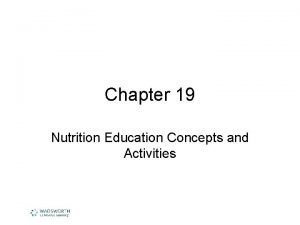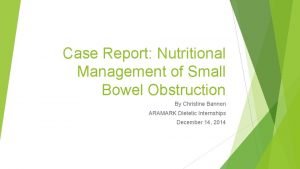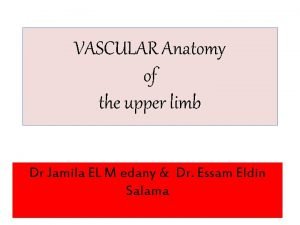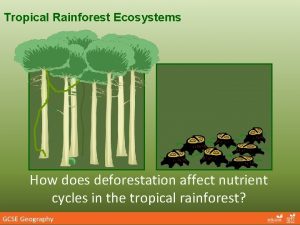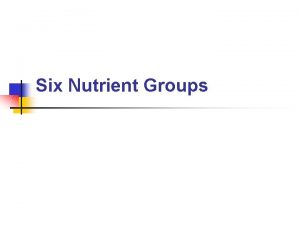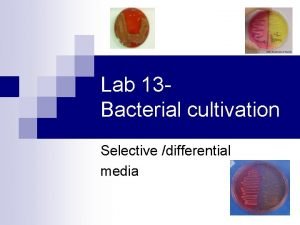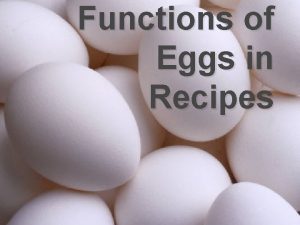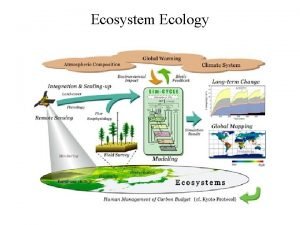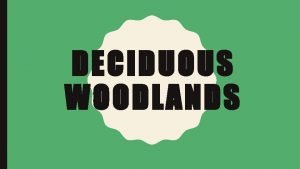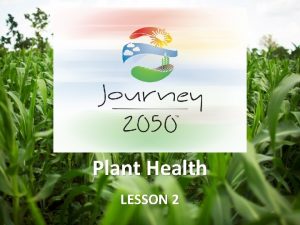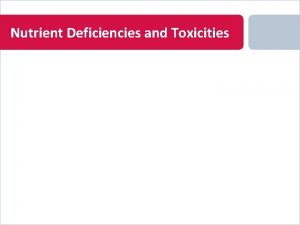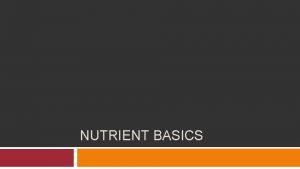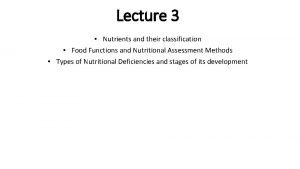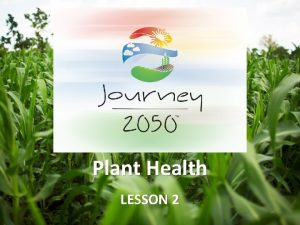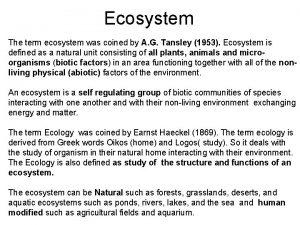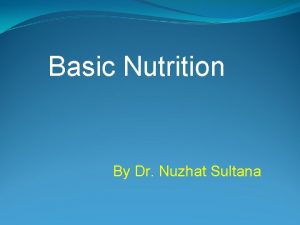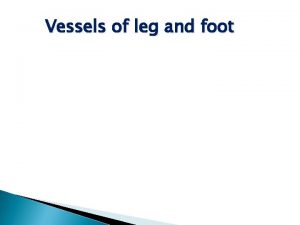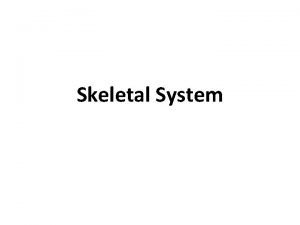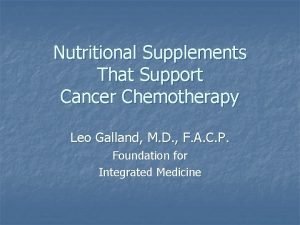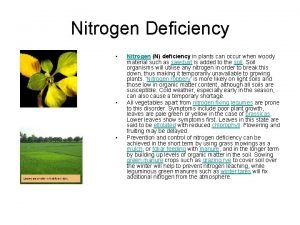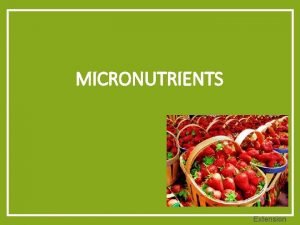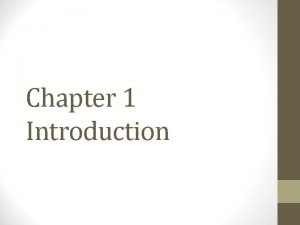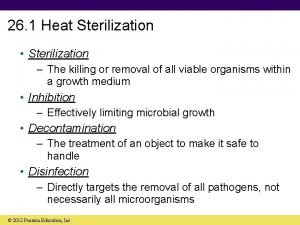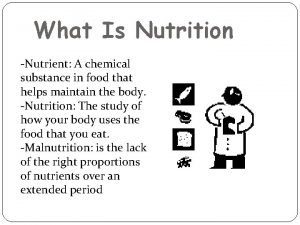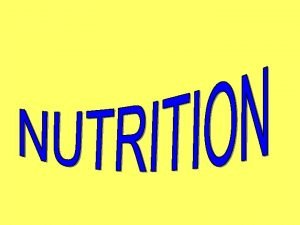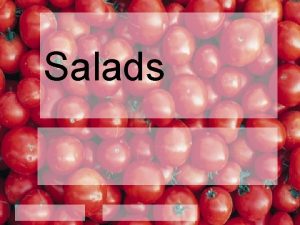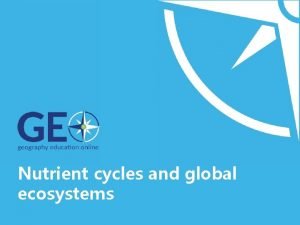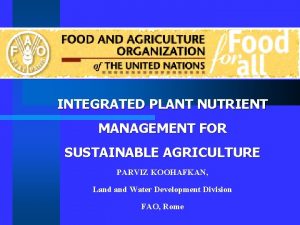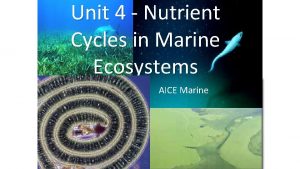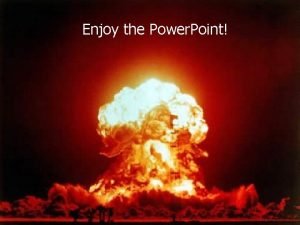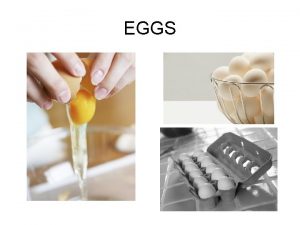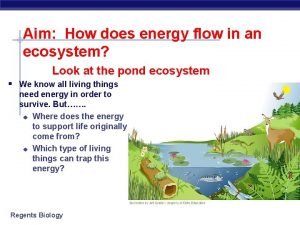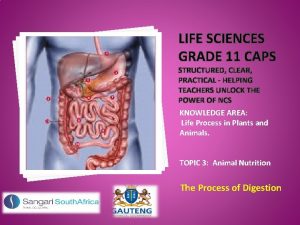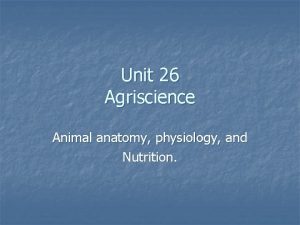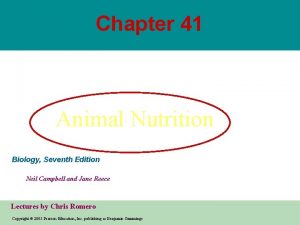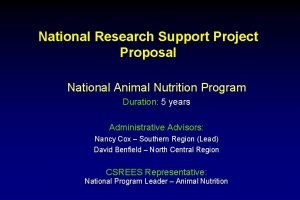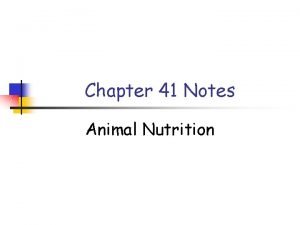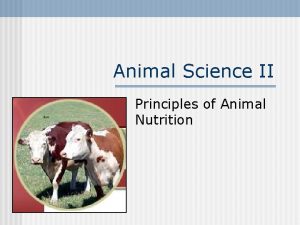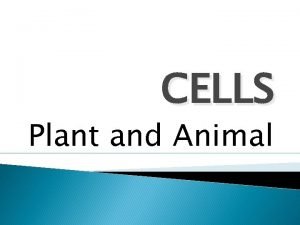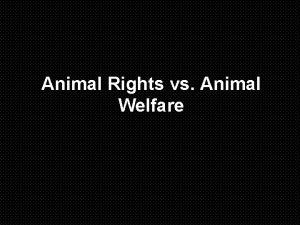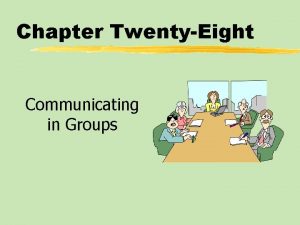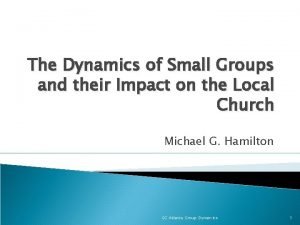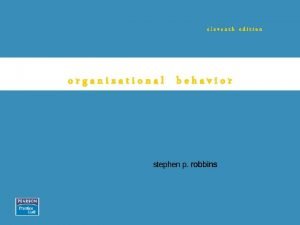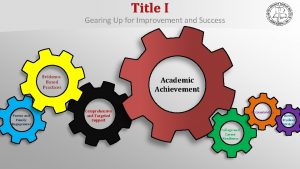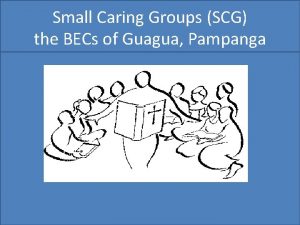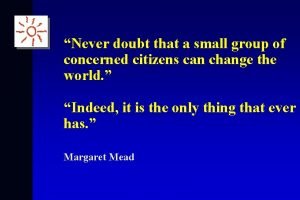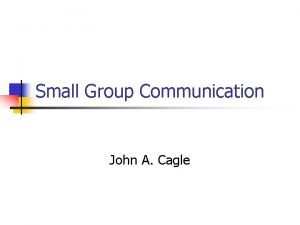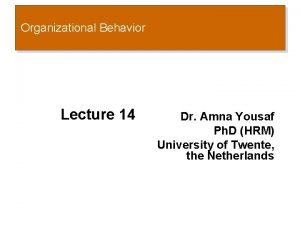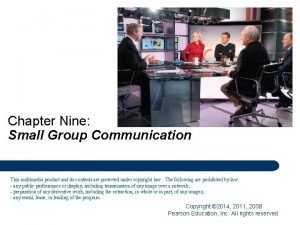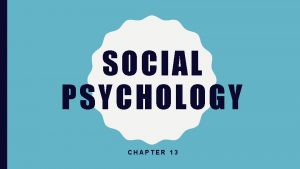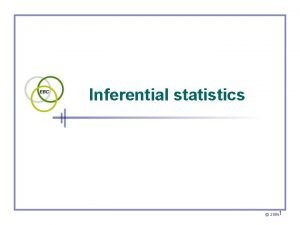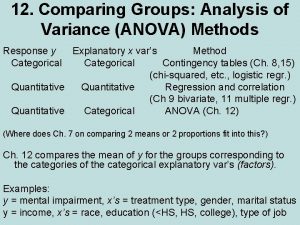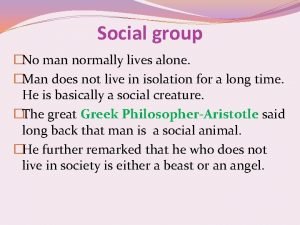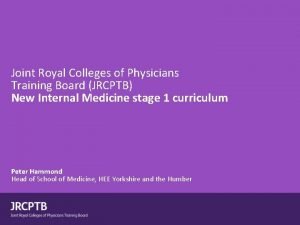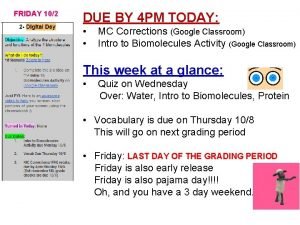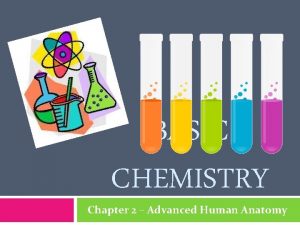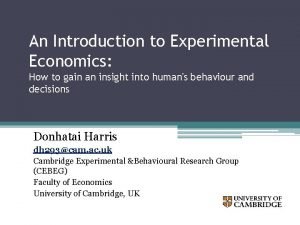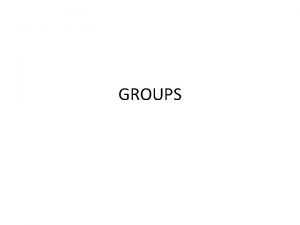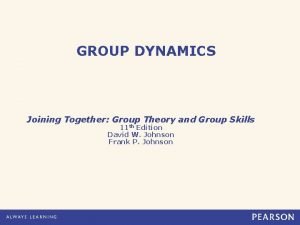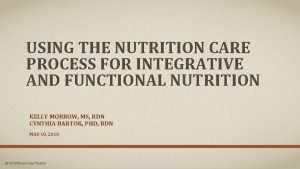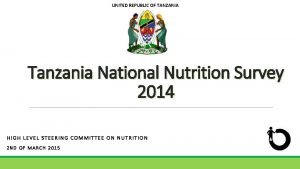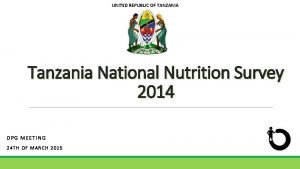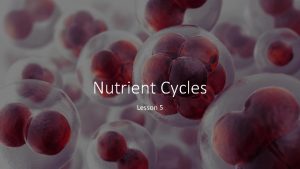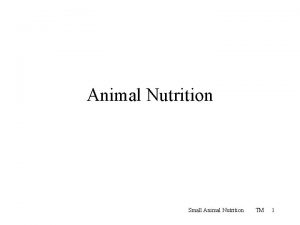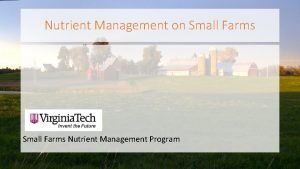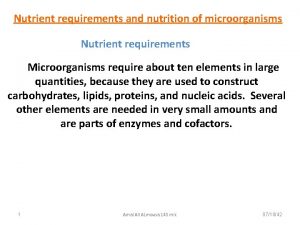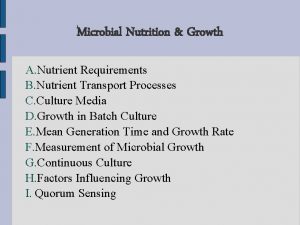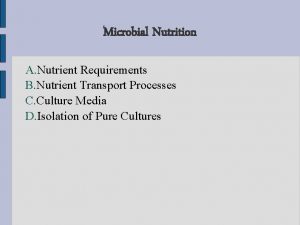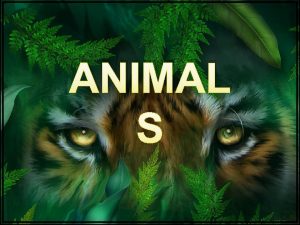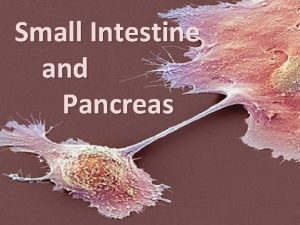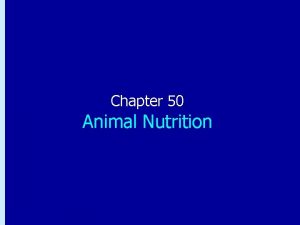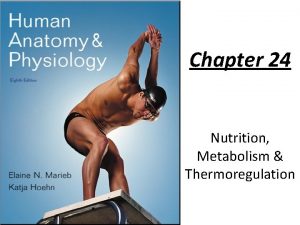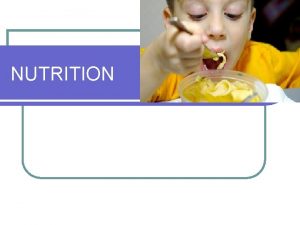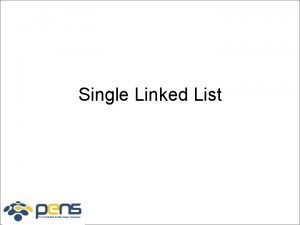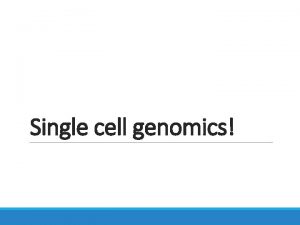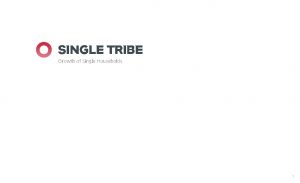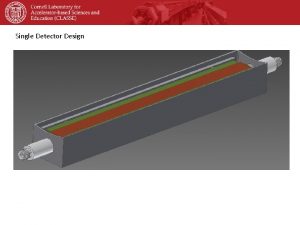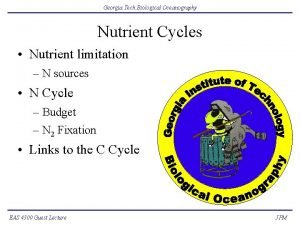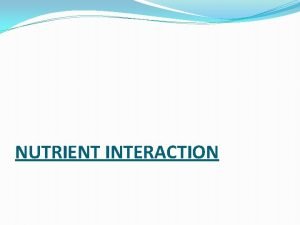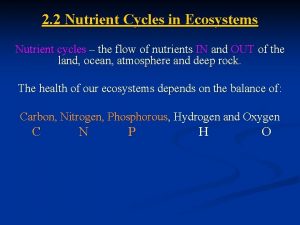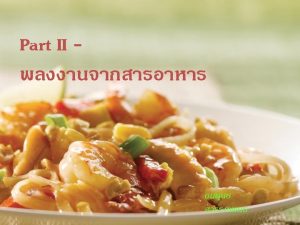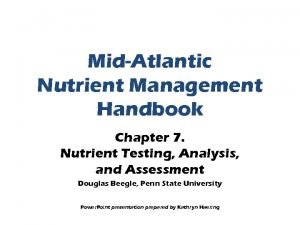Small Animal Nutrition Nutrition n Nutrient single group














































































- Slides: 78

Small Animal Nutrition

Nutrition n Nutrient- single group of foods of the same general chemical composition that supports animal life n There are six basic nutrient

Water n More important nutrient than any other nutrient n makes up 55 -65% of an animal’s body

Water n Aides in digestion n Transports nutrients n Regulates body temperature n Carries waste from the body n Supports respiration

Proteins n Complex nutrients composed of carbon, hydrogen, oxygen, and nitrogen n Develop and repairing body organs and tissues ¨muscles, nerves, skin, hair, hooves, and feathers

Proteins n Production of milk, wool, and eggs n Reproduction process of the developing fetus n Developing the young n Transmitting DNA

Carbohydrates Converting of food into energy n Made up of chemical elements n ¨ Carbon ¨ Hydrogen ¨ Oxygen n Supports breathing and digesting

Carbohydrates Production of heat for body warmth n Stores fat n Types of carbohydrates n ¨ Sugars ¨ Starch ¨ fiber

Fats n Chemical elements of ¨Carbon ¨Hydrogen ¨Oxygen n Same elements as carbohydrates but different combinations

Fats n Fats contain 2. 25 times more energy n Aid in absorbing fat-soluble vitamins ¨ A, D, E and K n Provides the essential fatty acids needed in an animal’s diet

Vitamins n Organic substances needed for specific biochemical reactions ¨ A, B, C, D, E and K n Needed in small amounts

Vitamins n Regulation of body glands ¨Digestive system ¨Absorption ¨Metabolism n The chemical processes occurring within a living cell or organism that are necessary for the maintenance of life. In metabolism some substances are broken down to yield energy for vital processes while other substances, necessary for life, are synthesized.

Minerals n Supply the material for building the skeleton and producing regulators such as enzymes and hormones n Divided into 2 groups ¨Macro ¨Micro

Macro vs. Micro n Macro ¨Seven major minerals needed in largest quantity and most likely lacking in the ration n Micro ¨Nine trace minerals needed in small amounts

Macro-minerals n Phosphorus n Calcium n Potassium n Sodium and chlorine n Sulfur n Magnesium

Micro-minerals n Iron n Zinc n Iodine n Molybdenum n Copper n Selenium n Cobalt n Fluorine n Manganese

Nutrient Deficiencies n Nutrition ¨ Process by which an animal receives and balanced food and water ration Grow n Maintain its body n Reproduce n Perform n n Nutrient ¨ substance that is necessary for an organism to live and grow

Nutrient Deficiencies n Slow growth n n (common of all nutrients) Water deficiency ¨ Overheating ¨ slowdown in n normal body functions occurs Carbohydrates ¨ lack of energy ¨ Lack of normal body ¨ loss of body heat functions

Nutrient Deficiencies n Proteins ¨ Normal growth development and repairing of body organs ex: muscles, nerves, skin, hair, hooves, and feathers suffers ¨ Protein deficiency may result n n n n Anorexia Anemia Edema Slow growth rate Low birth weight of young Lower milk production Decreased feed efficiency

Nutrient Deficiencies n Fats ¨Provides energy ¨aids in absorption of fat-soluble vitamins n Vitamins ¨various body functions will suffer when vitamins are lacking ¨Depends on the vitamins in question

Nutrient Deficiencies n Mineral ¨low deficiency rate of gains ¨poor feed efficiency ¨decreased reproduction ¨decrease in milk, meat, eggs, and wool production

Nutrition and Digestion of Small Animals

Ruminants n Considered as “forage consuming” ¨Ruminants have one stomach with multiple compartments n Food is acted on by millions of bacteria and microorganisms ¨Transform low-quality protein and nitrogen compounds n essential amino acids

http: //www. ca. uky. edu/agripedia/Classes/ASC 106/media/RUMEN. GIF

Four compartments n Rumen ¨largest compartment ¨contains bacteria & microorganisms n aids in the digestive process

Rumen Papillae http: //education. vetmed. vt. edu/Curric ulum/VM 8054/Labs/Lab 21/IMAGES/ru men%20 copy. jpg

Reticulum n Second compartment ¨aides in the formation of cud for regurgitation n Also known as the hardware stomach because it collects nails or pieces of wire

Reticulum http: //www. cvmbs. colostate. edu/ilm/outreach/necropsy/images/reticulum 1. jpg

Reticulum http: //arbl. cvmbs. colostate. edu/hbooks/pathphys/digestion/herbivores/retic. jpg

Omasum n Third compartment ¨removes water from food ¨Looks like the folds of a book

Omasum http: //courses. washington. edu/vertebra/453/photos/gut_photos/mammal_digestive_ photos. htm

Abomasum Fourth compartment n Referred to as the “true stomach” n ¨ Breaks down food material ¨ muscular movement ¨ secretes digestive juices n The material then passes into the small intestine

http: //www. yourdictionary. com/images/ahd/jpg/A 4 abomas. jpg

Non-Ruminants n Single-stomached n Mono-gastric ¨includes n Cats n Dogs n Rabbits n Birds all of the small animals


Rabbits n Non-ruminant ¨Consumes herbivores large amounts of roughage ¨Large cecum and colon between the small and large intestines n contains bacteria

Rabbit Digestive System http: //courses. washington. edu/vertebra/453/photos/gut_photos/mammal_digestive_photos. htm

Rabbits n Rabbits eat undigested feces ¨Coprophagy ¨Usually occurs late night or early morning ¨Makes use of undigested material so they can make full use of bacteria in cecum

Birds n Lack teeth ¨Saliva n Very is added to aid in swallowing little breakdown in the mouth n Gizzard ¨Largest digestive organ ¨Grinds and crushes

Digestive System- Bird http: //www. biologycorner. com/resources/bird_anatomy. jpg

Digestive Process of Non-Ruminants Food is broken down in mouth (except birds) n Passes to the stomach n Small Intestine n ¨ Primary n site of absorption Large Intestine ¨ Absorption of Water ¨ Addition of mucus

Fish Digestive System n Systems ¨Type n Some vary of feed determines teeth fish swallow their prey whole while others chew it up

Fish digestive system http: //animaldiversity. ummz. umich. edu/site/resources/Grzimek_fish/structure_function/digestive_system. jpg/medium. jpg

Nutrient Use n Maintenance ¨keeping constant ¨no gain or loss of weight ¨usually high in carbohydrates and fats n Growth ¨increase in body size ¨rations high in energy and protein

Nutrient Use n Reproduction ¨failures are a major result from poor nutrition ¨Contains a large amount of protein, minerals, and vitamins ¨Improper nutrition can affect conception rates and breeding ability

Reproduction n Babies that are underweight at birth, or which become an aborted fetus are often the result of improper nutrition to female during gestation

Nutrient Use n Lactation ¨time during which females are producing milk ¨Requires the proper nutrients to have large milk production

Lactation n Diet high in protein, calcium, and phosphorus. n The same nutrients contained in the milk are the same needed by a lactating female

Nutrient Use n Work and activity ¨Increased amounts of fats and carbohydrates are needed in a working diet to supply the extra energy needed ¨Hunting dogs need special diets because they require energy to chase after game

Feeding Terminology n Diet ¨ Feed n and water that an animal uses Amount and type of feedstuff is based upon: ¨ Animal Needs ¨ Kind of and amounts of nutrients contained in feed n Palatability- digestible and appeals to the animal ¨A good nutritious feed is only good if it is eaten

Feeding Terminology n Feed classifications ¨Roughages n made stems (or forages) up of leaves and the plants tender

Feeding Terminology n Concentrates ¨recommended for small animals as a regular part of their diet ¨High energy n Corn, ¨High n wheat, sorghum, barley, rye, oats protein Soybean meal, cottonseed oil meal, sunflower meal

Feeding Terminology n Supplements ¨contains a specific nutrient n Ration ¨feed that contains the right amount and proportion of nutrients

Specific Diets n Dogs and Cats n Commercial feed is the best ¨Puppies need diet higher in protein than adults and food intake is regulated by activity ¨Cats need 2 X the protein of dogs n 10% of their diet should be fat

Rabbits n Pellet type of commercial feed is best n Avoid feeding leafy green vegetables

Pocket Pets n Best to use pellet type commercial feed n If mixing ration; should have a wide range of food

Pocket Pets n Gerbils ¨Little green food in diet n Rats ¨can have dog food substituted n Ferrets ¨ can eat cat food

Pocket Pets n Mice ¨ will not overeat n Guinea ¨need pigs solid food to dull their teeth and a certain amount of Vitamin C

Amphibians & Reptiles n Prefer to eat animals if large enough ¨Tadpoles n eat pellets of rabbit, dog, or cat food ¨Turtles n Pieces of liver n Strawberries and other fruits

Amphibians & Reptiles n Snakes (in captivity) ¨Full grown can learn to eat canned dog ¨Variety of insects ¨Baby rodents ¨Frogs and toads n Lizards ¨Most eat insects

Birds n Diet mostly consists of seeds n Including cereal seeds and oil seeds n Fruit and nectar birds ¨eat oranges ¨Grapes ¨apple slices

Fish n Diet is affected by water temperature ¨ Higher n n temperature Increased food intake Variety of food should be given to decrease boredom

Fish Amount fish is fed should be amount it can eat in a few minutes to avoid contaminating water n Smaller fish n ¨ Flaked n food Larger Fish ¨ Shrimp ¨ Krill ¨ Plankton

Small Animal Reproduction

Sexual Reproduction n Two parents are required ¨ Natural n Male ¨ n Insemination Spermatozoa or male sex cell Female ¨ Egg or ovum (female sex cell)

Trout Spermatozoa http: //www. rennes. inra. fr/scribe/images/spermato. jpg

Sexual Terminology n Conception ¨ Creation n n of new life by fertilization Union of egg and sperm Estrus ¨ Heat period ¨ Female is receptive to breeding ¨ Stand for mating

Estrus- Stand for mating http: //www. clas. ufl. edu/jur/199912/images/balaguer_4. jpg

Sexual Terminology n Gestation ¨ Period of pregnancy ¨ Begins at conception ends at parturition n Ovulation ¨ Release n of egg Parturition ¨ Process of giving birth

Female Reproductive Anatomy n Ovary ¨ Primary reproductive organ ¨ Produces the female gamete (egg) n Embryo ¨ Developing young ¨ Mammals n Enters uterus after 3 -5 days

Female Reproductive Anatomy n Uterus ¨ Place n of embryo growth and development Cervix ¨ Part of uterus that contains rings ¨ Cervical mucus n Seals uterus during pregnancy

Female Reproductive Anatomy n Vagina ¨ Reproductive ¨ Urine n passageway excretio Vulva ¨ External opening of reproductive tract


Male Reproductive Anatomy n Testicle ¨ Primary organ ¨ Produces male gametes ¨ Externally held in scrotum n n Controls temperature Sheath ¨ Fold of skin ¨ Protective covering


Gestation n Time from conception to parturition (birth) ¨ Varies n for each species General Characteristics ¨ Increase size of breast and abdomen and appetite ¨ Restlessness n End of gestation

End of Gestation n Pocket pets and rabbits ¨ Nesting n n box should be provided Wood shavings Straw Paper Dogs and cats ¨ Birthing n n box One to three weeks prior Helps them to get comfortable with the setting

Gestation Period Species Cats Dogs Rabbits Hamsters Gerbils Rats Mice Guinea Pig Ferrets Period (days) 51 -65 (7 -9 weeks) 56 -70 (9 -10 weeks) 28 -32 (4 -4. 5 weeks) 30 -32 16 21 -24 56 -74 42
 Medium
Medium Foods used in nutrition activities should be nutrient-dense
Foods used in nutrition activities should be nutrient-dense Small bowel obstruction nutrition management
Small bowel obstruction nutrition management Deep venous palmar arch
Deep venous palmar arch Nutrient cycle of a tropical rainforest
Nutrient cycle of a tropical rainforest Nnn plant protein
Nnn plant protein Differential media
Differential media Emulsifier recipes
Emulsifier recipes Nutrient cycle in the serengeti
Nutrient cycle in the serengeti Deciduous woodland nutrient cycle
Deciduous woodland nutrient cycle Brays nutrient mobility concept
Brays nutrient mobility concept Energy in trophic levels
Energy in trophic levels Which nutrient practice was best journey 2050
Which nutrient practice was best journey 2050 Chlorsis
Chlorsis Nutrient basics
Nutrient basics Funtions of carbohydrate
Funtions of carbohydrate How does a plant resist disease and pests journey 2050
How does a plant resist disease and pests journey 2050 The term ‘ecosystem’ was coined by *
The term ‘ecosystem’ was coined by * Defination of nutrients
Defination of nutrients Biogeochemical cycles apes
Biogeochemical cycles apes Posterior tibial recurrent artery
Posterior tibial recurrent artery Nutrient artery
Nutrient artery Tamoxifen nutrient depletion
Tamoxifen nutrient depletion Nutrient deficiency in tomatoes
Nutrient deficiency in tomatoes Nutrient interactions
Nutrient interactions Immobile nutrients
Immobile nutrients Nutrient agar plate
Nutrient agar plate A chemical substance in food that helps maintain the body
A chemical substance in food that helps maintain the body Nutrient substance
Nutrient substance A main dish salad always contains some type of *
A main dish salad always contains some type of * Nutrient cyle
Nutrient cyle Ipns in agriculture
Ipns in agriculture A terrestrial food web
A terrestrial food web What nutrient cushions vital organs
What nutrient cushions vital organs Egg cooking style
Egg cooking style Energy flow trophic levels
Energy flow trophic levels Animal nutrition grade 11
Animal nutrition grade 11 Agriscience unit 26 self evaluation answers
Agriscience unit 26 self evaluation answers Animal nutrition grade 11 practical
Animal nutrition grade 11 practical Animal nutrition 7th edition
Animal nutrition 7th edition Unit 26 animal anatomy physiology and nutrition
Unit 26 animal anatomy physiology and nutrition Project proposal in animal science
Project proposal in animal science Animal nutrition notes
Animal nutrition notes Principles of animal science
Principles of animal science Sisd example
Sisd example Dataxin
Dataxin Waiting line management
Waiting line management Animal vs plant cell
Animal vs plant cell Venn diagram animal and plant cells
Venn diagram animal and plant cells Animal rights versus animal welfare
Animal rights versus animal welfare A small group usually has between three and twenty people.
A small group usually has between three and twenty people. Small group dynamics
Small group dynamics Formal small group networks
Formal small group networks Small group tutoring
Small group tutoring An introduction to group communication
An introduction to group communication Small caring group
Small caring group Never doubt a small group of concerned citizens
Never doubt a small group of concerned citizens Academic engagement
Academic engagement Small group communication theories
Small group communication theories Formal small group networks
Formal small group networks What is group discussion
What is group discussion Small group stages formats and culture
Small group stages formats and culture Between subjects design example
Between subjects design example Social loafing examples
Social loafing examples Y = a(b)^x
Y = a(b)^x Anova within group and between group
Anova within group and between group Types of social group
Types of social group Group 1 vs group 2 specialties
Group 1 vs group 2 specialties Group 2 nitrates
Group 2 nitrates Amino group and carboxyl group
Amino group and carboxyl group Amino group and carboxyl group
Amino group and carboxyl group In group out group
In group out group Group yourself or group yourselves
Group yourself or group yourselves Sumner's classification of social groups
Sumner's classification of social groups Joining together group theory and group skills
Joining together group theory and group skills Gcse food tech high skill dishes
Gcse food tech high skill dishes Nutrition care process
Nutrition care process Tanzania national nutrition survey 2019
Tanzania national nutrition survey 2019 Tanzania national nutrition survey 2018
Tanzania national nutrition survey 2018

